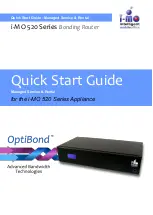
4.
Noting your port triggering rule and observing the destination port number of 6667, your router creates another
session entry to send any incoming port 113 traffic to your computer.
5.
The IRC server sends a return message to your router using the NAT-assigned source port (for example, port
33333) as the destination port and sends an “identify” message to your router with destination port 113.
6.
When your router receives the incoming message to destination port 33333, it checks its session table to see
if a session is active for port number 33333. Finding an active session, the router restores the original address
information replaced by NAT and sends this reply message to your computer.
7.
When your router receives the incoming message to destination port 113, it checks its session table and finds
an active session for port 113 associated with your computer. The router replaces the message’s destination
IP address with your computer’s IP address and forwards the message to your computer.
8.
When you finish your chat session, your router eventually senses a period of inactivity in the communications.
The router then removes the session information from its session table and incoming traffic is no longer accepted
on port numbers 33333 or 113.
Customize Internet Traffic Rules for Ports
171
Nighthawk X8 AC5300 Tri-Band WiFi Router














































